- Bitcoin (BTC) sank to $57,000 on May 1st, its lowest level since late February, amid broader risk-off sentiment and macroeconomic pressures.
- Investors are bracing for the Federal Reserve’s interest rate decision, with expectations that rates will remain unchanged but clues on future cuts are eagerly awaited.
- Factors like outflows from US bitcoin ETFs, poor reaction to new Hong Kong spot ETFs, and Binance founder’s sentencing over money laundering charges have also impacted bitcoin’s price.
Bitcoin slid below $57,000 on Wednesday to kick off May, reaching its lowest level since late February. The drop comes as investors await the Federal Reserve‘s upcoming interest rate decision.
Bitcoin Retreats Amid Broader Risk-Off Sentiment
The cryptocurrency fell as much as 7% to $56,526, its lowest level since Feb. 27, according to CoinMetrics. Bitcoin has declined about 10% over the past week and saw its worst month since November 2022 in April.
The drop extends bitcoin’s retreat from March all-time highs and comes amid a broader pullback from risk assets like stocks. Investors are focused on the Fed’s policy meeting conclusion Wednesday afternoon. The central bank is expected to hold rates steady, but investors want hints from Fed Chair Jerome Powell on the path forward.
“The broader macro backdrop has deteriorated for assets like crypto that thrive on liquidity,” said Geoff Kendrick, Standard Chartered‘s head of digital asset research, in a note Wednesday. Outflows from bitcoin ETFs and a poor reception of new spot bitcoin ETFs in Hong Kong also weighed on prices this week.
Bitcoin Bulls Expect Strong Recovery Later This Year
Bitcoin investors remain optimistic about a significant price recovery later in 2022 despite recent weakness. Analysts at Bitfinex said bitcoin could continue to trade in a range over the next few weeks given macro and geopolitical pressures.
“We could see a 1-2 month consolidation in bitcoin prices trading in a range with swings of $10,000 on either side,” the analysts said. “We expect the positive impact of the halving, which has brought about a reduction in bitcoin supply, will be seen in later months.”
The halving occurred in 2020 when the bitcoin reward for miners was cut in half. Previous halvings have preceded massive bull runs in bitcoin. Investors believe the reduced supply combined with increasing institutional adoption could drive prices sharply higher in the second half of 2022. For now, bitcoin remains sensitive to shifts in broader risk sentiment and liquidity conditions.
Bottom Line
Bitcoin has retreated over 10% in the past week amid a risk-off shift in markets and ahead of the Fed’s policy decision. While prices could chop sideways in the near-term, investors remain bullish on a significant bitcoin rally later this year due to tailwinds from the 2020 halving and growing institutional adoption. The Fed’s stance on liquidity and interest rates, as well as the broader macroeconomic environment, will drive bitcoin’s price action over the next couple months.














